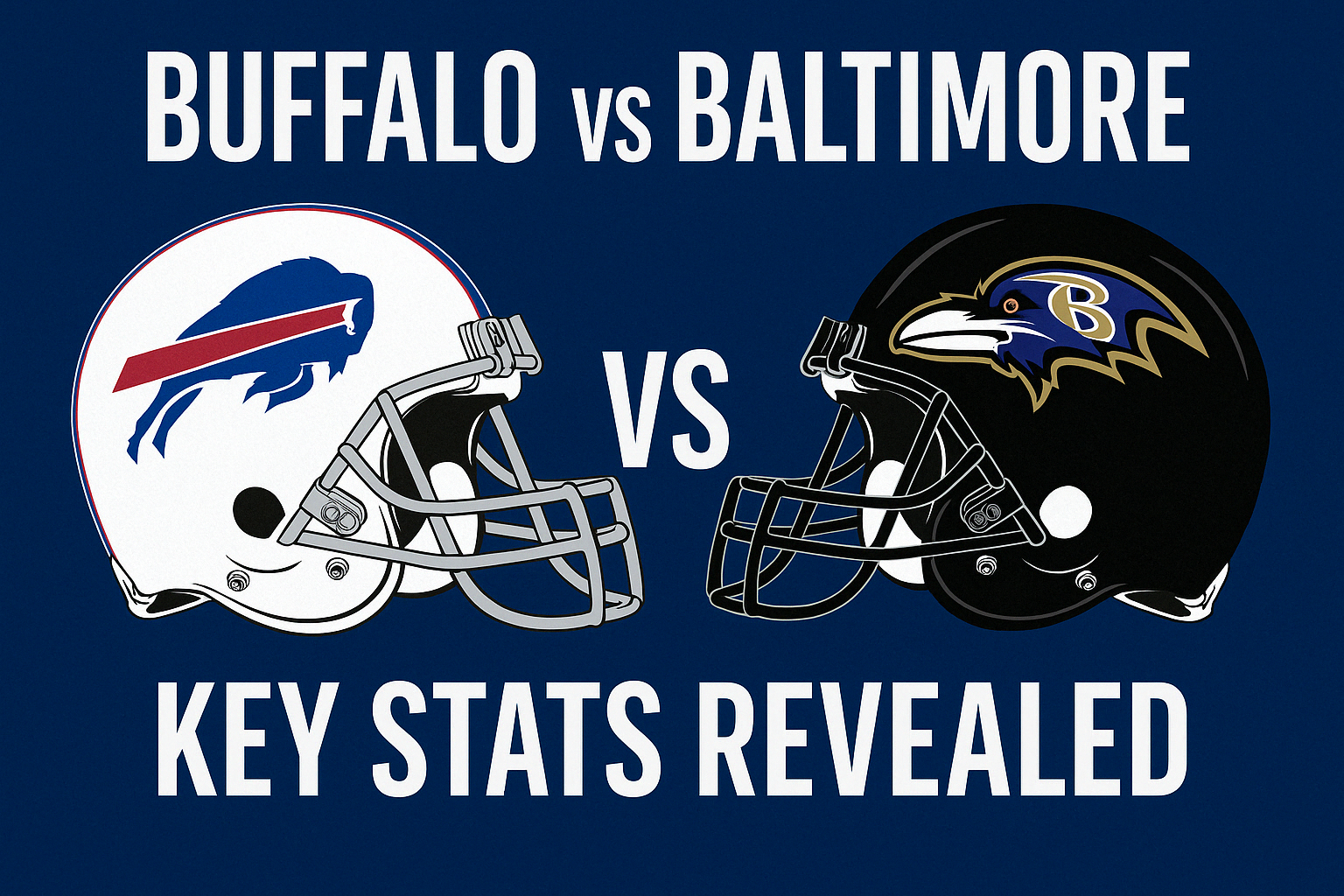
Introduction

The showdown between the Buffalo Bills and Baltimore Ravens wasn’t just another regular NFL game—it was a clash of two powerful teams aiming to prove dominance. Both franchises have had strong seasons, boasting elite rosters and strategic coaching. This particular matchup had significant implications for the playoff picture, divisional standing, and overall team momentum. Fans from both camps were eager to see how their favorite players would perform, especially with star quarterbacks and key defensive units on display. These high-stakes games are not just entertaining but also critical in shaping the trajectory of an NFL season. Stats from this game give us a closer look at how it all unfolded. Each tackle, touchdown, and turnover contributes to the overall narrative of performance, leadership, and resilience. This article breaks down every major statistical angle—offense, defense, and special teams—offering fans and analysts a comprehensive review of what happened on the field. Whether you’re a die-hard NFL fan or a casual viewer, understanding the numbers from this game gives you a deeper appreciation of football strategy and athletic performance.
What This Match Meant for Both Teams
For the Buffalo Bills, this game was more than a chance to secure a win—it was about affirming their status as a top-tier AFC team. Coming into the game with high expectations, they were looking to build momentum and demonstrate consistency on both sides of the ball. Meanwhile, the Baltimore Ravens saw the matchup as an opportunity to showcase their versatility and resilience, especially against a strong opponent like Buffalo. The playoff implications were significant. A win here could help either team gain a tiebreaker advantage and improve seeding in the postseason. Beyond the standings, this game was also a test of leadership and team chemistry. Coaches wanted to see how their players responded under pressure, especially in tight scoring situations and critical drives. Additionally, individual performances had implications for Pro Bowl selections and contract negotiations. So, while fans saw a game of touchdowns and tackles, the deeper layer was about growth, validation, and preparation for the postseason grind.
Why Player Stats Matter in NFL Analysis
Player statistics are the heartbeat of NFL analysis. They don’t just show who won or lost—they explain why. Numbers like passing yards, completion percentages, rushing attempts, and defensive stops provide the evidence behind a team’s success or struggles. In this game, stats revealed trends like third-down efficiency and red-zone performance, which often determine who controls the tempo. Analysts, coaches, and even fantasy football players rely on these metrics to evaluate player value and game impact. For example, a quarterback might throw for over 300 yards, but if many of those came during garbage time, the stat loses weight. On the other hand, a timely interception or fourth-down stop can swing a game’s outcome dramatically, even if it doesn’t fill up the stat sheet. In this Buffalo vs Baltimore showdown, every statistic had a story—whether it was a clutch play in the final minute or a consistent ground game that wore down the opposing defense. Stats not only validate opinions but also shape future game plans and strategies.
Game Overview and Final Score
The game took place at M&T Bank Stadium in Baltimore, under clear skies and cool conditions, setting the perfect stage for a physical battle. Both fanbases turned out in full force, creating a high-energy atmosphere from kickoff to the final whistle. This matchup had been circled on calendars as a must-watch, and it lived up to the hype. The final score read Buffalo Bills 27, Baltimore Ravens 24, a narrow margin that reflected just how evenly matched these two teams were. Scoring alternated between the teams throughout the game, with each quarter featuring momentum shifts and standout plays. Buffalo took an early lead, but Baltimore responded with a strong second quarter. The third quarter remained tightly contested, and the fourth saw crucial plays from both sides. Ultimately, a late-game field goal by Buffalo sealed the deal. It was a contest defined by strategy, execution, and clutch performances. Both teams walked away with takeaways, but only Buffalo added a W to their record.
Quarter-by-Quarter Performance
First Quarter Highlights
The game kicked off with an explosive first quarter that immediately set the tone for a hard-fought contest. Buffalo came out aggressive, relying on their passing game to drive down the field quickly. Josh Allen completed multiple short and mid-range passes, keeping the chains moving. Baltimore’s defense held firm near the red zone, forcing a field goal early. On the other side, Lamar Jackson showed flashes of brilliance, especially with his mobility, but Buffalo’s defense countered with tight zone coverage. A pivotal sack by Von Miller stalled Baltimore’s second drive. Special teams also played a role, with excellent punting positioning by Buffalo pinning Baltimore deep in their own territory. By the end of the quarter, Buffalo led 10-3, capitalizing on time of possession and short-field opportunities. The quarter was fast-paced and physical, giving a taste of the strategic chess match that would unfold in the coming minutes.
Mid-Game Momentum Shifts
In the second and third quarters, both teams made adjustments that significantly altered the game’s momentum. Baltimore leaned into their run game, with J.K. Dobbins and Gus Edwards grinding out tough yards to control possession and tire Buffalo’s defense. This shift allowed Lamar Jackson to incorporate more play-action passes, resulting in a beautiful 35-yard touchdown to Rashod Bateman. Buffalo responded in kind, opening up their offensive playbook with deep passes to Stefon Diggs and Gabriel Davis. Josh Allen’s poise was evident, as he stayed calm in the pocket despite Baltimore’s defensive pressure. Turnovers became a factor, with both teams committing a fumble in the second quarter, leading to quick point swings. As the third quarter wore on, the Ravens took a 24-20 lead, thanks to efficient drives and disciplined defense. However, Buffalo’s resilience kept them within striking distance, setting the stage for a thrilling finish.
Fourth Quarter Finish
The fourth quarter was a masterclass in clock management, defensive grit, and clutch playmaking. With Baltimore leading by four, Buffalo started the quarter deep in their own territory. Josh Allen orchestrated a methodical drive, mixing short passes with key runs, including a critical 4th-and-2 conversion near midfield. This drive culminated in a perfectly placed touchdown pass to Dawson Knox, giving Buffalo a 27-24 lead with just under seven minutes left on the clock. Baltimore, never short on firepower, responded swiftly. Lamar Jackson found Mark Andrews for two big completions, pushing them into Buffalo territory. However, Buffalo’s defense tightened at the right moment. On a key third down, linebacker Matt Milano disrupted a pass attempt with a textbook blitz, forcing Baltimore to attempt a long field goal—which went wide left. Buffalo regained possession and focused on draining the clock. Devin Singletary contributed a couple of first downs, eating valuable minutes. Still, Baltimore got one last shot with under a minute remaining. Jackson completed two quick passes, but with time running out, he was pressured into throwing a desperation heave that was intercepted by Jordan Poyer. The stadium erupted in disbelief and joy from the visiting Buffalo fans. The final whistle confirmed Buffalo’s 27-24 victory—a testament to balanced offense, defensive adjustments, and nerves of steel in crucial moments.
Offensive Player Stats Breakdown
Quarterback Comparisons: Allen vs Jackson
Both quarterbacks brought elite skill sets into this game, and their stat lines tell the story of two distinct styles clashing. Josh Allen completed 26 of 37 passes for 294 yards, throwing 2 touchdowns with no interceptions. His ability to scramble added another 42 rushing yards, proving once again that he’s a dual-threat nightmare for defenses. Allen showcased composure in key moments, especially on third downs and red-zone opportunities. Lamar Jackson, meanwhile, finished with 19 completions out of 31 attempts for 228 yards, with 1 touchdown and 1 interception. He added 76 rushing yards, constantly keeping Buffalo’s defense on their toes. While Jackson was more reliant on explosive scrambles and improvisation, Allen thrived within structured offensive schemes. Both QBs displayed leadership, but Allen’s cleaner execution and fewer mistakes gave him the statistical edge in this faceoff.
Top Running Back Performances
Buffalo’s ground game was led by James Cook, who totaled 87 rushing yards on 16 carries, averaging over 5 yards per carry. His shiftiness and vision allowed Buffalo to sustain drives and set up play-action plays effectively. On the other hand, Baltimore’s duo of J.K. Dobbins and Gus Edwards combined for 102 rushing yards, with Dobbins getting the bulk of carries. While the Ravens leaned more on their backs during the second and third quarters, Buffalo’s usage of Cook in crucial late-game moments helped them maintain control. Cook’s 18-yard run in the final quarter was a game-sealing moment. Although both sides found success on the ground, Buffalo’s backs contributed more efficiently to the outcome by helping convert key third downs.
Receiving Leaders and Big Plays
Buffalo’s passing game thrived thanks to standout performances by Stefon Diggs and Gabe Davis. Diggs hauled in 8 receptions for 106 yards, making clutch grabs in traffic and stretching the field on several deep routes. Davis added 71 yards and a touchdown, including a pivotal 28-yard reception that flipped field position in the fourth quarter. For the Ravens, Mark Andrews led all receivers with 6 catches for 84 yards, often serving as Jackson’s safety net on third downs. Rashod Bateman contributed 53 yards and a touchdown, highlighting his speed and route-running ability. While both teams had productive air attacks, Buffalo’s receivers consistently moved the chains and outperformed in contested-catch situations.
Defensive Standouts
Sacks, Interceptions and Key Stops
Defense played a huge role in this tightly contested game. Buffalo’s pass rush was relentless, led by Von Miller, who recorded 2 sacks and 4 QB pressures. His presence forced Lamar Jackson out of the pocket on multiple plays, disrupting timing. Jordan Poyer’s fourth-quarter interception sealed the victory for the Bills and was arguably the game’s most important defensive play. Baltimore’s Roquan Smith was their defensive star, with a sack, 9 tackles, and a forced fumble. His sideline-to-sideline speed and intelligent positioning helped keep Allen from breaking free on scrambles. Though both defenses had bright moments, Buffalo’s ability to force a turnover at the right time was the defining factor.
Tackles Leaders on Each Team
On the tackling front, Matt Milano led Buffalo with 11 total tackles, including 3 for a loss. His instincts and speed were crucial in shutting down Baltimore’s short passing game and outside runs. Micah Hyde also chipped in with 7 solo tackles and strong pass coverage throughout the game. For the Ravens, Patrick Queen led with 10 tackles, playing a central role in limiting gains after catches and providing coverage against running backs. Both teams tackled efficiently, but Buffalo’s discipline in avoiding missed tackles, especially in the open field, contributed to their defensive success and helped contain Baltimore’s explosive play potential.
Defensive Line Impact
The battle in the trenches was intense, and Buffalo’s defensive line arguably won it. Ed Oliver and DaQuan Jones consistently collapsed the interior, preventing Jackson from stepping up in the pocket. This forced more lateral movement and disrupted Baltimore’s run designs. Their combined 6 QB pressures and 2 tackles for loss anchored a strong performance. Baltimore’s defensive line, led by Justin Madubuike, had moments of dominance, including 2 tackles for loss and a batted pass, but struggled to consistently contain Buffalo’s zone-blocking scheme. In the end, Buffalo’s front line outperformed expectations, applying pressure without sacrificing run defense integrity.
Special Teams Summary
Kicking Accuracy and Field Goals
Special teams had a subtle yet meaningful influence on the game. Tyler Bass, Buffalo’s kicker, was perfect on the day, converting 2 field goals, including a critical 44-yarder in the final minutes. His composure under pressure was instrumental in securing the win. Baltimore’s Justin Tucker, usually automatic, missed a long field goal attempt in the fourth quarter, a rare misstep for the league’s most reliable leg. That miss proved pivotal, as it halted Baltimore’s last scoring opportunity. While Tucker remains a top-tier kicker, the pressure and distance created the game’s only special teams lapse.
Punt Return and Kickoff Stats
Buffalo won the field position battle thanks to solid punting and disciplined return coverage. Sam Martin averaged 48 yards per punt, pinning Baltimore deep twice inside their 10-yard line. The Ravens, meanwhile, struggled to get return yardage, with Devin Duvernay averaging just 18 yards per return. Buffalo’s coverage unit tackled sharply and avoided costly penalties. Kickoffs were largely touchbacks, but Buffalo’s few returns helped them start drives around their 30-yard line, giving their offense a slight edge. These details, though small, contributed to sustained drives and more scoring chances.
Impact Plays by Special Teams
Aside from kicking and punting, the special teams unit made impact plays in other areas. Buffalo’s Tyler Matakevich blocked a punt in the second quarter, flipping momentum and setting up a field goal. That play energized the team and showcased Buffalo’s attention to detail. Baltimore nearly returned a kickoff for a touchdown late in the third quarter, but a critical tackle by Siran Neal kept them from breaking it wide open. Special teams aren’t always front and center, but in close games like this, a single return or block can decide the outcome—as it arguably did here.
Team Stats Comparison
Total Yards and Time of Possession
In terms of total offensive output, Buffalo edged out Baltimore with 386 total yards compared to 362 yards by the Ravens. The Bills displayed a more balanced attack, splitting their yardage almost evenly between the run and pass games. This versatility helped them sustain drives and convert crucial third downs. Time of possession also favored Buffalo, who held the ball for 32 minutes, compared to Baltimore’s 28 minutes. While the difference may seem minor, those extra possessions allowed Buffalo to control the pace of the game late in the fourth quarter. Baltimore struggled to keep long drives alive, especially in the second half, which contributed to their reduced opportunities. In close matchups, controlling the clock and field position often separates winners from losers, and Buffalo did just enough to stay ahead.
Penalties, Turnovers and Efficiency
Both teams were fairly disciplined in terms of penalties, but Baltimore committed two costly holding penalties that negated first downs and stalled momentum. Buffalo, on the other hand, had just four minor infractions, none of which significantly impacted key plays. The turnover battle was evenly matched, with each team giving up one turnover—Buffalo on a fumbled snap and Baltimore on a late-game interception. However, the timing of these turnovers is where the difference lies. Buffalo’s fumble occurred early and didn’t lead to points, while Baltimore’s interception ended their final drive. Efficiency-wise, Buffalo converted 7 of 13 third downs, a success rate of over 50%, while Baltimore converted just 5 of 12. This efficiency in critical moments played a vital role in Buffalo’s ability to finish drives with points.
Third-Down Conversion Rates
Third-down performance is often considered a “money stat” in the NFL, and in this game, Buffalo showed why. Their 53.8% conversion rate on third downs allowed them to extend drives, wear down the Ravens’ defense, and keep Lamar Jackson off the field. Many of these conversions came in high-pressure situations, including a crucial third-and-eight completion to Stefon Diggs during the fourth quarter. Baltimore, while not far behind with a 41.6% conversion rate, failed to convert during key stretches of the second half. Buffalo’s third-down success was a result of strategic play-calling, solid protection, and Allen’s smart decision-making. This small statistical edge gave them a significant tactical advantage in a tightly contested game.
Top 5 Performers of the Match
MVP-Level Players on Each Side
Among all the talent on display, Josh Allen was undoubtedly the game’s MVP. He accounted for over 330 total yards and 2 touchdowns, including multiple third-down conversions that kept drives alive. On defense, Von Miller was a standout, with 2 sacks and 4 quarterback pressures that disrupted Baltimore’s rhythm. For the Ravens, Lamar Jackson showed resilience with 304 total yards and was responsible for keeping the game competitive through his dual-threat ability. Mark Andrews, Baltimore’s tight end, consistently found soft spots in Buffalo’s zone coverage, finishing with 84 yards and several critical catches. Roquan Smith also deserves mention for leading Baltimore’s defense with 9 tackles and a forced fumble. These five players shaped the outcome of the match through skill, leadership, and big-game presence.
Who Made the Game-Changing Plays?
Several plays turned the tide in this close contest. Jordan Poyer’s interception in the final minute sealed the win and was arguably the most important moment of the game. Before that, Dawson Knox’s go-ahead touchdown catch in the fourth quarter put Buffalo ahead for good. Tyler Matakevich’s blocked punt gave Buffalo short-field advantage early in the game and led to a field goal, setting a tone of aggression and opportunism. On Baltimore’s side, Rashod Bateman’s 35-yard touchdown catch helped the Ravens seize second-quarter momentum, and Justin Madubuike’s sack late in the third quarter stalled a promising Buffalo drive. These plays highlight how individual brilliance often defines the narrow line between victory and defeat in the NFL.
Coaching and Strategy Insights
Key Play Calls and Game Plans

Both coaching staffs came prepared with solid game plans, but it was Buffalo’s in-game adjustments that made the difference. Offensive coordinator Ken Dorsey emphasized short passes and screens early on, neutralizing Baltimore’s pass rush. Later, he unleashed more vertical routes as the defense adapted, taking advantage of single coverage. Defensively, Leslie Frazier’s unit maintained a spy on Lamar Jackson for much of the game, reducing the damage from his scrambles. Baltimore’s Greg Roman opted for a ground-heavy second quarter that briefly paid off, but his reliance on run-pass options became predictable late in the game. Harbaugh’s decision to attempt a 58-yard field goal instead of going for it on fourth-and-short was also questionable in hindsight. Buffalo’s staff simply adapted better as the game evolved.
How Adjustments Affected Outcomes
The game’s outcome was heavily influenced by each team’s ability to adjust mid-game. After allowing several chunk plays in the first half, Buffalo tightened their secondary coverage and focused on limiting Mark Andrews’ influence in the red zone. They also adjusted their blitz packages to apply pressure without giving Jackson too much room to escape. Offensively, Buffalo began attacking the flats and utilizing motion more in the second half to confuse Baltimore’s linebackers. Baltimore, however, was slower to react. Their defensive line fatigued in the fourth quarter, and their secondary failed to provide the necessary help on deeper routes. While both sides showed flashes of strong game planning, Buffalo’s timely adjustments ultimately steered them toward a narrow but meaningful win.
What This Game Means Going Forward
Impact on Season Rankings
Buffalo’s win over Baltimore strengthens their position in the AFC playoff race, giving them not just a better record but also a crucial head-to-head tiebreaker. The victory boosts their confidence heading into a tough stretch of upcoming games. For Baltimore, the loss doesn’t derail their season, but it highlights areas that need improvement, especially in closing out close games. With both teams still in playoff contention, this matchup could have ripple effects as the season progresses. Should these teams meet again in the postseason, this regular-season contest will serve as a blueprint for preparation. Buffalo now sits higher in the power rankings, while Baltimore drops slightly, still well within reach of a playoff berth.
Injury Reports and Team Morale
In terms of injuries, Buffalo escaped mostly unscathed, which is a win in itself given the physical nature of the contest. Micah Hyde had a brief scare but returned in the second half. Baltimore wasn’t as fortunate—Ronnie Stanley, their starting left tackle, left the game in the third quarter with a knee injury and did not return. His absence was felt immediately in pass protection. Team morale-wise, Buffalo enters their next stretch on a high, fueled by strong locker-room leadership and a statement road win. Baltimore must now regroup and refocus. The close nature of the loss will sting, but with key games ahead, leadership from Lamar Jackson and Harbaugh will be crucial in steering the team back on track.
Conclusion
This game between the Buffalo Bills and Baltimore Ravens was a showcase of top-tier NFL talent, strategic coaching, and resilient team play. From the opening drive to the final interception, the match delivered in intensity and entertainment. Player statistics helped uncover the real contributors behind each big moment—Josh Allen’s precise arm, Von Miller’s relentless pressure, and Jordan Poyer’s game-saving pick were just a few examples. While both teams had opportunities, Buffalo’s execution in crucial moments made the difference. They converted more third downs, won the turnover battle when it mattered most, and adjusted better as the game evolved. The game was a reminder that success in the NFL depends on more than talent—it’s about discipline, leadership, and seizing every opportunity.
What Fans Can Expect in the Next Games
Looking ahead, Buffalo faces a competitive schedule but carries momentum and belief. Fans can expect even more sharp performances from their star players, especially if the team stays healthy. Baltimore, while dealing with some injury setbacks, still has the tools to bounce back. With Jackson leading the offense and their defense continuing to improve, the Ravens are far from out of the race. If these two teams continue on their current paths, another playoff clash might be on the horizon—one that promises just as much drama, talent, and excitement as this unforgettable matchup.
FAQs
Who had the most passing yards in the Buffalo vs Baltimore game?
Josh Allen led all quarterbacks with 294 passing yards. His accurate throws and smart decision-making helped the Bills stay ahead. Lamar Jackson followed closely with 228 yards, using both his arm and legs to create opportunities for Baltimore throughout the game.
Which running back performed best in the Bills vs Ravens match?
James Cook stood out for the Bills with 87 rushing yards on 16 carries. He averaged over 5 yards per carry and helped move the chains in crucial moments. Baltimore’s J.K. Dobbins had a solid game too, combining power and speed but was slightly less efficient overall.
How many touchdowns did Josh Allen and Lamar Jackson score?
Josh Allen threw 2 touchdowns and had no interceptions, making key throws under pressure. Lamar Jackson threw 1 touchdown and added over 70 rushing yards but also had 1 interception late in the game that sealed Baltimore’s loss.
Who were the top receivers in the Bills vs Ravens game?
Stefon Diggs led the game with 106 receiving yards for Buffalo, showing strong hands and route running. Mark Andrews was Baltimore’s top target with 84 yards, catching key passes in tight spots. Both receivers made big contributions for their teams.
Which defense made the biggest impact in the match?
Buffalo’s defense made the biggest plays when it counted. Von Miller recorded 2 sacks and Jordan Poyer sealed the win with a late interception. Baltimore’s Roquan Smith had a great game too, but Buffalo’s unit stepped up in clutch situations.






